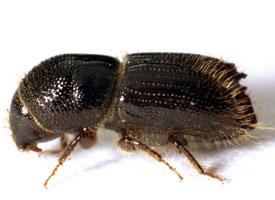
Greutăți și măsuri
| Lungime | de la 4 la 5,5 mm |
|---|
Descrierea animalului
The European spruce bark beetle, scientifically named Ips typographus, is a small yet significant beetle species belonging to the family Curculionidae, the weevils. This beetle, often not exceeding 4 to 5.5 millimeters in length, has a cylindrical body that is predominantly black to dark brown in color. The physical appearance of Ips typographus is characterized by its hard exoskeleton and the distinctively patterned ridges on its elytra (wing covers), which resemble typographic symbols, hence its name. The beetle's antennae are elbowed, with a club at the end, which is a common feature among weevils.Ips typographus is notorious for its role as a pest, primarily targeting spruce trees (Picea species), which are prevalent in European forests. The beetle's life cycle and behaviors are intricately linked to the health and condition of spruce forests. Typically, Ips typographus populations remain under control and do not cause significant damage in healthy forests. However, during periods of drought, storms, or when trees are weakened by disease, the beetles can multiply rapidly, leading to outbreaks that can devastate spruce stands.
The life cycle of Ips typographus begins when adult females bore into the bark of a spruce tree to lay their eggs in specially excavated galleries. These galleries, which can be observed upon peeling back the bark of an infested tree, are meticulously constructed and serve as a nursery for the developing larvae. The larvae feed on the inner bark, disrupting the tree's ability to transport nutrients and water. This feeding activity can lead to the death of branches or entire trees. After completing their development, the larvae pupate within the bark, emerging as adults ready to infest new trees.
Ips typographus is highly adapted to exploit the vulnerabilities of spruce trees. The beetles can detect trees that are weakened or stressed, using volatile compounds emitted by the trees as cues. They also employ pheromones to communicate and coordinate mass attacks on susceptible trees, overwhelming the trees' defenses. In addition to the direct damage caused by feeding and tunneling, the beetles can introduce blue-stain fungi (Ophiostomatales) into the trees. These fungi can further weaken and eventually kill infested trees by blocking the water-conducting tissues.
The impact of Ips typographus extends beyond the health of individual trees and can affect forest ecology, economy, and management practices. Large-scale infestations can lead to significant economic losses in timber production and necessitate costly management interventions. Forest managers employ various strategies to control Ips typographus populations, including sanitary logging to remove infested trees, the use of trap trees and pheromone traps to monitor and reduce beetle populations, and promoting forest diversity to enhance resilience against outbreaks.
Conservation and forest management practices are crucial in mitigating the impact of Ips typographus. By maintaining healthy, diverse forests and promptly addressing factors that weaken trees, such as disease, drought, or damage, the risk of devastating beetle outbreaks can be reduced. As climate change and human activities continue to influence forest ecosystems, understanding and managing pests like Ips typographus will remain a vital aspect of sustainable forest management.
Fotografii noi cu animale
Top 10 animale
- Dolphin gull (Leucophaeus scoresbii)
- Diana monkey (Cercopithecus diana)
- Moustached guenon (Cercopithecus cephus)
- Greek tortoise (Testudo graeca)
- Stone loach (Barbatula barbatula)
- Galápagos tortoise (Geochelone nigra complex)
- Japanese macaque (Macaca fuscata)
- Russian tortoise (Testudo horsfieldii)
- Common flying dragon (Draco volans)
- Galápagos penguin (Spheniscus mendiculus)